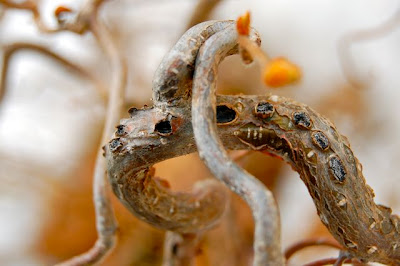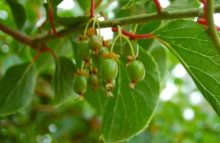| The rather gross-looking cankers of Eastern filbert blight, a fungus that’s not a fun-guy! |
 Run out right now and inspect your corkscrew hazel shrub (Corylus avellana ‘Contorta’) for bumps like these. If you see semi-regular, black cankers along the stems (like I did), your hazel has Eastern filbert blight (Anisogramma anomala). If left to its own devices, this will kill the branch, spread, and eventually kill the hazel tree or shrub.
Run out right now and inspect your corkscrew hazel shrub (Corylus avellana ‘Contorta’) for bumps like these. If you see semi-regular, black cankers along the stems (like I did), your hazel has Eastern filbert blight (Anisogramma anomala). If left to its own devices, this will kill the branch, spread, and eventually kill the hazel tree or shrub.
Pruning out infected wood well below the cankers, before leaf buds break (now!), is about the only way to treat this unsightly mess. Here are more details from Oregon State University and from Cornell [PDF].
Filbert blight is now a major problem for North American hazelnut growers who also grow C. avellana, the European branch of the hazelnut family. It’s a stronger producer but more susceptible to blight than our native American hazel. For nut growers, filbert blight is an economic catastrophe. For ornamental gardeners like us, it’s just a sorry pain in the neck. I suspect the blighty conditions that took their toll on our tomatoes for the last couple of seasons may have been just right for this fungus, too.
Once the leaves unfurl, it’ll be next to impossible to see anything amiss on the branches. So look closely now and prune out and destroy any affected branches before the blight can spread further.
[UPDATE: Thanks for this great info to Dr. Thomas Molnar, Department of Plant Biology & Pathology, Rutgers University, New Brunswick (emphasis, mine):]
The contorted hazel is highly susceptible, so even though you pruned it, I would bet that it pops up again. You will see the stromata developing in July and August. It can not reinfect other hazelnuts until the next spring though as the EFB cankers take a while to mature.
There is a EFB-resistant contorted hazelnut with purple leaves now available. It is called ‘Red Dragon’. It is a great plant. ‘Red Majestic’ is another purple contorted variety available, although it is highly susceptible to EFB like the original contorta. Red Dragon is available from a couple Oregon nurseries, but it is very expensive since it was just released last year and few plants are available.





10 comments
Helen:
Bless you for getting the word out on this pernicious blight. We lost a wonderful cortorted specimen two years ago to this very thing! Started exactly the way your photos show but was very aggressive and lethal. I now grow Clematis through its contorted branches.
Knowing what to look for and what to do while branches are bare seems to be your speciality. Interesting even to unblighted people!
Such a shame that something which has to be destroyed is fascinating to see.
Esther
Barry, I just learned about this horror myself, when I was standing outside waiting for Sarah and her pup to go for a walk. Looked at my Corylus and went: Eeeeeeeeeew! Out came the iPhone, and I researched it on the spot. Still shudder when I look at the picture.
Esther, if it were just "interesting" to look at I'd try to live with it. But it's pretty aggressive and fatal to the C. avellana species. Hope it never makes its way across the ocean.
Bless you for finally having identified what I have been looking for, for years and years! I help run a family owned garden centre called Black Forest Garden Centre and first noticed this disease about 18 years ago. I took pictures and sent it to our suppliers, but no one could identify it. Dirr never mentioned it in his book, and no description was ever mentioned in my pest and disease book Can't at the moment recall the name of it. Thank you thank you
were doing research on the fungus at Rutgers in NJ, USA. We are looking for samples to grow in the lab as part of a genetic diversity study. Any chance you still have some around?
Tom Molnar
I hope not, Tom, but I've been watching it like a hawk. If it returns, I'll let you know.
Helen: Thanks for this. I just discovered it on my own corkscrew hazel – unfortunately it's pretty extensive (I'm a novice gardener so I didn't spot it early enough) and your blog posting has confirmed the worst.
Barry: Interesting thought, leaving it as a natural trellis. Does anybody know if there's a problem doing that? I think the bare branches in winter are its best feature and would hate to lose those from our garden but I worry about the blight propagating to other plants (or other corkscrew hazels, although I haven't seen any in my neighbourhood). Is that a danger?
– Trevor
Trevor, I don't know for certain, but I suspect that, as a fungus, the spores and/or fruiting bodies might hang around for a while if not destroyed.
I did receive further info from Tom Molnar that I'd intended to update the post with before I got sidetracked. I'll add that now.
Hi Helen:
Thanks for the feedback – and the update on your original post on this. That's good to know.
And thanks for doing this blog! I stumbled across it while searching for information on EFB and have scanned your other posts. Very interesting stuff. I've added you to my RSS feeds so I can follow your writing. Keep it up! 🙂
As a follow-up, information on Red Dragon can be found here:
http://agsci.oregonstate.edu/sites/default/files/research/RedDragon_Release_PropA.pdf
Does anybody know if they're available in the GTA?